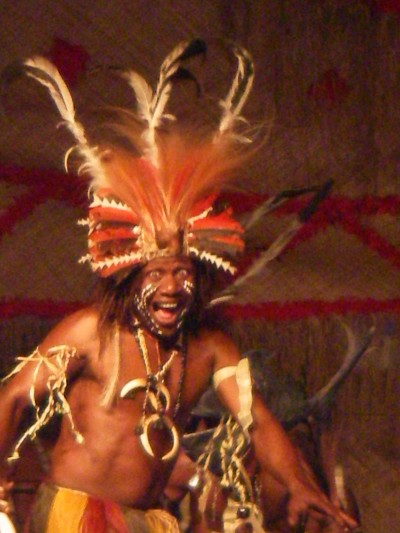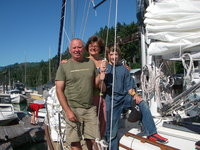
Hannah
12 February 2009 | Whangarei, New Zealand
26 November 2008 | NZ
26 November 2008 | Opua, New Zealand
24 November 2008 | Opua, New Zealand
21 November 2008 | NNE of New Zealand
18 November 2008 | Minerva Reef
17 November 2008 | Minerva Reef Yacht Club
17 November 2008 | Minerva Reef
14 November 2008 | Minerva Reef
12 November 2008 | Nuku'alofa, Tonga
10 November 2008 | Nuku'alofa, Tonga
31 October 2008 | Kelefesia Island
21 October 2008 | Neiafu, Va'vau
11 October 2008 | Neiafu, Va'vau, Tonga
07 October 2008 | Niuatoputapu
23 September 2008 | Niuatoputapu (
19 September 2008 | Apia, Samoa
17 August 2008 | Apia, Samoa
03 August 2008 | Pago Pago, American Samoa
03 August 2008 | Pago Pago, American Samoa
Eat the Music II
03 August 2008 | Pago Pago, American Samoa
Tracy

Oh yes. The 10th Pacific Arts Festival. It has been held every four years since the 1970's (a sensible interval) and grown from a $200,000 budget to over a $4,000,000 budget. 2000 performers. 27 countries which occupy 30,000,000 sq. km. The sites for both four and eight years from now are chosen. The American Samoa Committee engaged the island in every way possible and the country is proud of having had so many visitors. The one thing that everybody said is that they cleaned up the garbage ahead of time and during the festival, and that they hope some inspiration will seed itself. The arts are dancing, singing, music, theater, cooking, quilt making, painting, sculpture, healing, navigation, architecture, photography, jewelry, and fashion. The venue winds like a necklace from Pago inner harbor on a grassy recreation area used for centuries that has a small pavilion to a beach area with a high school sports court (The Sharks is the team) and many fale (open palm huts) for workshops and crafts and then way out of town to a large Veterans Memorial Stadium for opening/'closing ceremonies and big stage acts. We went everyday. All day. We went for two evenings after it was officially over when some delegations stayed and just wanted to do more. Each country decides who to send, so that may be the customary (Papua New Guinea war dances) or the contemporary (Maori rappers), professional or community-based. The Samoan organizing committee initially rejected the application of Papua New Guinea because the women dance traditionally without wearing tops, but after unimaginable hours of meetings chose to allow them to perform--and sure enough one day the newspaper's collage of festival photos on the front-page included those topless women from Rapa Nui at a hotel show. Other issues were the minimally x-rated Hawaii theater group and the racy, up-to-the minute New Caledonia mime group. Again, with advocacy, they were there. Sadly, three deaths happened among performers and dignitaries (cerebral malaria, possible suicide, and during sleep after exercise), reminding us of life's fragility.
Three favorites out of many:
1) Rapa Nui (Easter Island). See photo of me as groupie between the two out-of-costume guys selling CDs in Photos Volume 2. Mata Toa Group did dance music in insouciant traditional outfits and became the "bad boy" hits especially with the Samoan women (there's that fluidity thing again). As my neighbor at the formal closing ceremony (contentless speeches, pleasant delegation parades, presentation of mounds of gifts to participants, including many tapa and canned wahoo, not tuna) lamented that they had predictably not shown on time for the march of delegations, she said "Oh yeah, in my house it's just (falsetto) Rapa Nui, Rapa Nui, Rapa Nui!"
2) Samoan Tattoo. Many things happened at an intimate level with just a few people in the fale where people from each country did small presentations, etc. Some of these were things that would have gone on anyway: if your kid was sick, you took him to the traditional healer from Pago at the festival rather than at his house, and the healer proceeded with massage, herbs, and advice right there. Many young American Samoan women about 15-16 got traditional tattoos which extend around their thigh from hip to knee. They are done with a pig's tooth hammer hit with a second wooden tool, with two assistants holding and dabbing the skin. We sat for an hour with a girl's female relatives, who were there to support her in her pain, and whispered about the tradition and the process.
3) Ocean Voyaging Society. The Cook Islanders came by sailing double outrigger canoe and did a workshop discussing the Society. They touched on the complexities of reviving traditional Polynesian navigation and canoe. It is an expensive process for a country to build a large sailing canoe ($300,000) and therefore the relevance and meaning has to be assessed closely. The canoes have duel operating systems--the traditional navigator and a GPS/compass navigator who are usually kept separate- and have modern gear like EPIRBS and life rafts. Many get excited, learn from the remaining elders, then get back into earning a living and raising a family and forget about it. So the amazingness, as in one story about a blind, one-legged navigator in the Cooks who felt the swell and smelled the air, is balanced by realities of Westernized living.
People, people, people. Talking, talking, talking. In the bar, on the individually garnished Toyota truck buses, at the mini-mart. There were certainly cruisers present and some tourists who came just for the event, but by and large the audience was the performers and the Samoans. And the performers were everywhere. We ate the music. Oh yes, the Fijian fashion designers, like artists everywhere, don't want to ship stuff home so sold their work at give away prices at the booth; I persuaded Steve to buy a high fashion black shirt with deconstructed burlap patch and shell buttons and a lavalava of silver brocade with black, silver, and white vines on it as well as a sturdy buckle and pockets. Photo will follow someday. He has a suitable outfit for every formal event to which he will ever go.
Back in the harbor, many boats were damaged in the crossing from the Society Islands, so there are sails to be sewn, booms to be welded, masts to be replaced, refrigerators to be sorted out, couplers to be put in. With some very dangerous occurrences, everybody has pulled together in amazing ways. Because this is American Samoa, postage rate for parcels are US domestic and without duty. We fared well in the weather but couldn't resist at least one purchase that was not 100% justified but came under the aegis of greater safety at sea.
On August 19 I will fly from Apia, Samoa (formerly Western Samoa) to Seattle to see Nolan and visit friends. Steve will stay in Apia working on Hannah, ie varnishing I hope. Nolan has been doing well, working and reconnecting; we regularly email on the subject of who misses who more. On September 4 Marty, Kas, and I will go to Los Olivos, CA, to take Nolan to Midland School. You can track me down there through stevetracynolan@gmail.com. I am very much looking forward to the visit.
Three favorites out of many:
1) Rapa Nui (Easter Island). See photo of me as groupie between the two out-of-costume guys selling CDs in Photos Volume 2. Mata Toa Group did dance music in insouciant traditional outfits and became the "bad boy" hits especially with the Samoan women (there's that fluidity thing again). As my neighbor at the formal closing ceremony (contentless speeches, pleasant delegation parades, presentation of mounds of gifts to participants, including many tapa and canned wahoo, not tuna) lamented that they had predictably not shown on time for the march of delegations, she said "Oh yeah, in my house it's just (falsetto) Rapa Nui, Rapa Nui, Rapa Nui!"
2) Samoan Tattoo. Many things happened at an intimate level with just a few people in the fale where people from each country did small presentations, etc. Some of these were things that would have gone on anyway: if your kid was sick, you took him to the traditional healer from Pago at the festival rather than at his house, and the healer proceeded with massage, herbs, and advice right there. Many young American Samoan women about 15-16 got traditional tattoos which extend around their thigh from hip to knee. They are done with a pig's tooth hammer hit with a second wooden tool, with two assistants holding and dabbing the skin. We sat for an hour with a girl's female relatives, who were there to support her in her pain, and whispered about the tradition and the process.
3) Ocean Voyaging Society. The Cook Islanders came by sailing double outrigger canoe and did a workshop discussing the Society. They touched on the complexities of reviving traditional Polynesian navigation and canoe. It is an expensive process for a country to build a large sailing canoe ($300,000) and therefore the relevance and meaning has to be assessed closely. The canoes have duel operating systems--the traditional navigator and a GPS/compass navigator who are usually kept separate- and have modern gear like EPIRBS and life rafts. Many get excited, learn from the remaining elders, then get back into earning a living and raising a family and forget about it. So the amazingness, as in one story about a blind, one-legged navigator in the Cooks who felt the swell and smelled the air, is balanced by realities of Westernized living.
People, people, people. Talking, talking, talking. In the bar, on the individually garnished Toyota truck buses, at the mini-mart. There were certainly cruisers present and some tourists who came just for the event, but by and large the audience was the performers and the Samoans. And the performers were everywhere. We ate the music. Oh yes, the Fijian fashion designers, like artists everywhere, don't want to ship stuff home so sold their work at give away prices at the booth; I persuaded Steve to buy a high fashion black shirt with deconstructed burlap patch and shell buttons and a lavalava of silver brocade with black, silver, and white vines on it as well as a sturdy buckle and pockets. Photo will follow someday. He has a suitable outfit for every formal event to which he will ever go.
Back in the harbor, many boats were damaged in the crossing from the Society Islands, so there are sails to be sewn, booms to be welded, masts to be replaced, refrigerators to be sorted out, couplers to be put in. With some very dangerous occurrences, everybody has pulled together in amazing ways. Because this is American Samoa, postage rate for parcels are US domestic and without duty. We fared well in the weather but couldn't resist at least one purchase that was not 100% justified but came under the aegis of greater safety at sea.
On August 19 I will fly from Apia, Samoa (formerly Western Samoa) to Seattle to see Nolan and visit friends. Steve will stay in Apia working on Hannah, ie varnishing I hope. Nolan has been doing well, working and reconnecting; we regularly email on the subject of who misses who more. On September 4 Marty, Kas, and I will go to Los Olivos, CA, to take Nolan to Midland School. You can track me down there through stevetracynolan@gmail.com. I am very much looking forward to the visit.
Comments
| Vessel Name: | Hannah |
| Vessel Make/Model: | Mason 44 |
| Hailing Port: | Brinnon, Washington, USA |
| Crew: | Steve Wrye, Tracy Willett, Nolan Willett |
Gallery not available
Hannah's Crew

Who: Steve Wrye, Tracy Willett, Nolan Willett
Port: Brinnon, Washington, USA